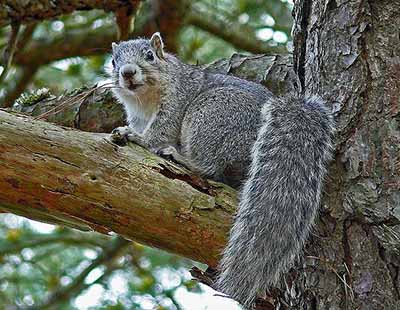
ANNAPOLIS—While some squirrel species can be found hiding in neighborhood bushes or rummaging through city trash cans, the Delmarva Peninsula fox squirrel largely stays in rural, woodland habitats.
Deforestation and hunting throughout the first half of the 20th century, however, pushed the squirrel toward extinction and helped land it on the federal endangered species list. On Monday—more than 40 years after the squirrel’s addition—the U.S. Fish and Wildlife Service will remove it from that list.
The delisting comes at a time when the species, which is twice as large as the common gray squirrel, has a population size and range greatly above its historic lows. In 1967, the squirrel’s range had been narrowed 90 percent, from the whole of the Delmarva Peninsula to four counties in Maryland. Research from the Wildlife Service estimates there are now 17,000 to 20,000 squirrels across 10 counties and 135,000 acres of forest in Delaware, Maryland and Virginia.
The population bounceback stems largely from interstate and federal conservation efforts. The Wildlife Service’s Endangered Species Program, for example, monitors, protects and rehabilitates at-risk species. For the Delmarva Peninsula fox squirrel, translocating individuals from areas of higher to lower squirrel density gave rise to 11 new, thriving populations.
“It takes a lot of time and effort to get to the point where you can take something off the list,” said Thomas Miller, a ranger at the Blackwater National Wildlife Refuge. “It’s a very big deal for us when it happens.”
Blackwater is based in Dorchester County, Maryland, home to one of the region’s largest fox squirrel populations. As such, the refuge helped contribute squirrels for translocation projects, according to Miller.
Blackwater also bought additional woodland in part to increase protected squirrel habitat, Miller said. “It’s kind of a major species that we feel ownership for in this refuge.”
“We are proud to be a major partner in the recovery of the Delmarva fox squirrel after 40 years of conservation efforts,” Maryland Department of Natural Resources Secretary Mark Belton said in a press release issued Friday. “This success story would not have happened without the cooperation of federal and state agencies and conservation groups, as well as the private property owners of Maryland and Delaware who provided habitat for the endangered species on their own land.”
Under the Endangered Species Act, endangered species are those at risk for extinction across a “significant portion” of their range. When establishing the endangered species list, the Wildlife Service looks at factors such as habitat destruction, disease, predation and effects of human intervention, and reviews the status of each listed species every five years.
Reviews in 2007 and 2012 concluded reclassification and ultimately delisting of the squirrel was warranted. After completing the regulatory steps, which include opening the decision to public and scientific comments and revisions, the Wildlife Service had the green light for removal.
“The natural world is amazingly resilient, especially when a broad collection of partners works together to help it,” said U.S. Senator Ben Cardin, D-Md., a senior member of the Environment and Public Works Committee, said in the press release. “Today’s announcement is a major victory for the Endangered Species Act and the Delmarva fox squirrel itself, and much credit is due to the federal biologists who have worked for decades to rebuild the squirrel’s populations…”


You must be logged in to post a comment.